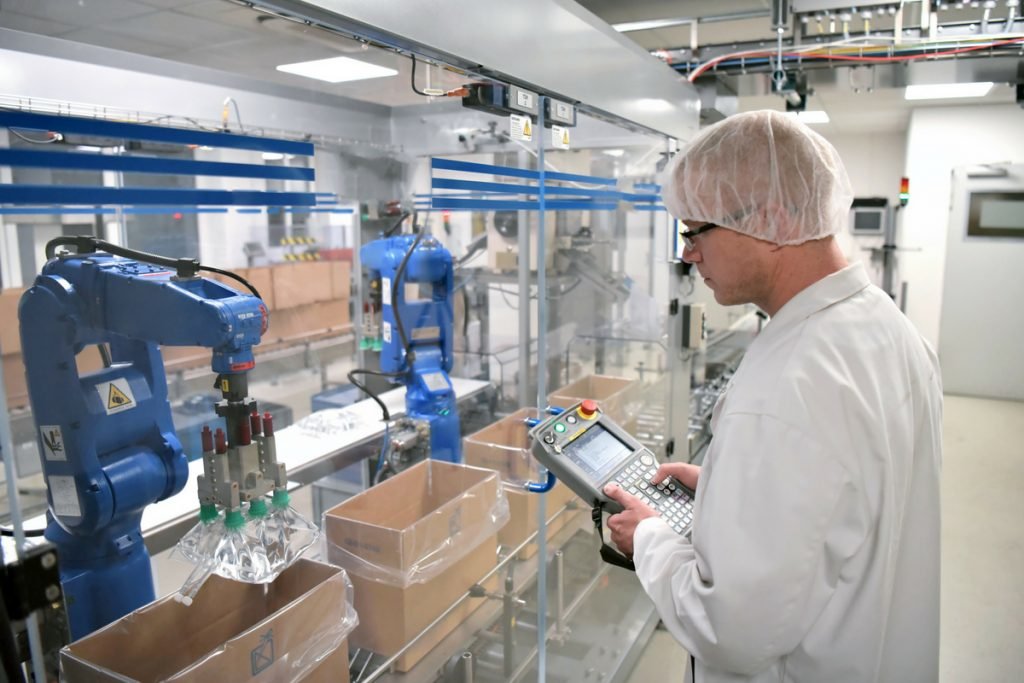Robots vs People – The future of Pharmaceutical Engineering

India had inexpensive labour and availability in plenty; training needed was minimal since these were mind-numbing repetitive jobs and there were plenty of people without formal educations available – either breadwinners or spouses looking to augment the family income.
These were the good old, or the bad old days depending on your perspective. A lot has changed since then globally and also in India. Labour being expensive in the developed world companies sought increasing amounts of automation and engineering and machinery manufacturers complied keeping pace with new demand. Computerisation added a new dimension and the new machinery, with embedded computer chips could be controlled by a computer or a PLC (Programmable Logic Controller).
Today most filling and sealing units come with automatic cartonators and inspection units. Even automated packing into larger corrugated boxes and taping can be carried out automatically depending on how labour saving the manufacturer wishes to be.
Apart from packaging operations even manufacturing operations like scooping ingredients, weighing, mixing, granulating etc. could be operated through PLCs. Not only did these computer-controlled machines do these manufacturing jobs but also automatically recorded actions – data that is so vital in the pharma manufacturing industry was automatically captured, eliminating the elaborate printed forms that were filled manually as the batch progressed.
Then, not to be left behind, the Regulatory bodies, headed by US FDA, upped the ante and demanded validation of these computers or PLCs. At this stage, these were not called Robotics but be that as it may proof was needed that these would not go awry, and that a batch could not be made without the right GMP (Good Manufacturing Practice) and that these could not be manipulated!
India, way behind, was slow in automation and with price control and the domestic market not ‘shining’ so much. Indian pharma companies eyed the western markets and started exporting generic versions of off-patent molecules. This had more profits as there was no cap on pricing and they charged what the market could bear. Many Big Pharma companies in India soon had twin manufacturing sites – one for export (more automated) and one for domestic (still labour intensive!)
To err may be human but in the pharma manufacturing business no errors can be tolerated, as the manufacture of drugs and the meticulous compliance of GMP is a must. Since human beings are error-prone, automation is really the way forward. Automation is increasingly becoming central to pharmaceutical manufacturing, minimising workload and maintaining higher levels of accuracy. Enter Robotics! Robotics are automated systems that incorporate sensors, an intelligent decision-making algorithm, and an actuator. Robots generally fall into two main categories. Arm robots mimic the structure of the human arm and are good for pick-and-place functions. Parallel robots comprise a platform mounted on legs. These systems provide more precision than arm robots.
There are strong economic reasons for implementing robotic systems. The cost of robots, like that of other established technology, has been steadily decreasing. Replacing a piece of outdated or slower equipment with the flexibility and sustainability of robotic automation will be seen by any business person as making good fiscal sense.
With pharma industry growth and the significant costs of new discovery drugs, there is growing demand for Robotics in the areas of Clinical Trials and drug discovery and the laboratory. Big Pharma is investing in AI in a big way. This is all the more evident from GSK’s deal last year with British AI firm, Exscientia. This could signal a revolution for drug development that could radically speed up the drug discovery process, helping patients in urgent need of specialist treatments.
Pharmaceutical robotic machines also minimise manufacturing costs by reducing human labour. Such machines are 3 to 4 times faster than humans and have the capacity to work 3 shifts. Reduction in production costs is expected to raise the return on investment in the long run, thus driving costs down for these products, and driving up affordability, in the future.
Robots are also capable of performing tasks in areas that humans cannot like potentially hazardous settings for e.g. Proximity to biological dangers, the threat of radioactive contamination, and toxic chemotherapy compounds. Relatively unglamorous work of lab technicians and hence unavailability of workers are also being filled up by Robotics.
Another emerging area is the work currently done by Pharmacists. Several hospitals and larger health care clinics utilise robotics to scan barcodes and dispense medication. Robotic pharmacies are expanding rapidly within hospitals and clinics. Retail pharmacies may pose a challenge due to existing laws and will depend on the pace of change of regulations. There is no doubt that Robotics is essential to the future scientific or commercial research and manufacturing.
What then is the future in countries like India with unemployment and a surfeit of labour? Could Robots take jobs? The answer is a resounding YES! The World Economic Forum’s Future of Jobs study predicts that 5 million jobs will be lost before 2020 as artificial intelligence, robotics, nanotechnology and other socio-economic factors replace the need for human workers. The good news is that those same technological advances will also create upwards of 2 million new jobs. However, manual and clerical workers who find themselves out of work are unlikely to have the required skills to compete for the new roles. Most new jobs will be in more specialised areas such as computing, mathematics, architecture and engineering. Governments and employers in every sector are being urged to retrain and re-skill workers to avoid a crisis. In India, there is already a desperate and urgent call for re-skilling!
Categories
Recent Posts
Subscribe
Never miss a post from Fabtech. Sign up to receive updates direct to your inbox.
